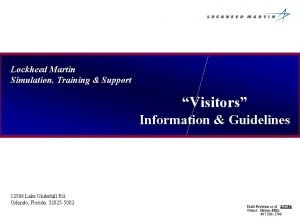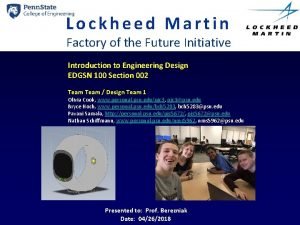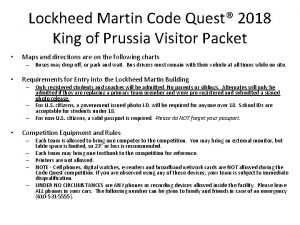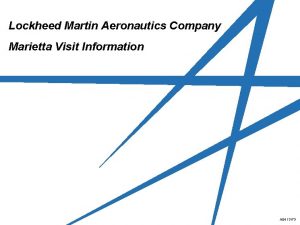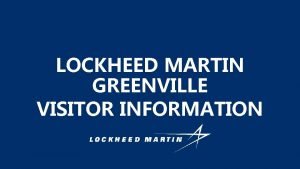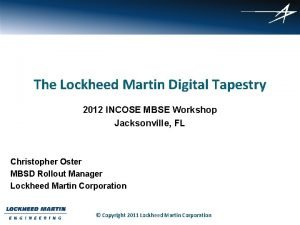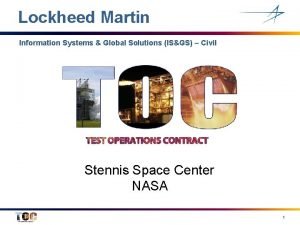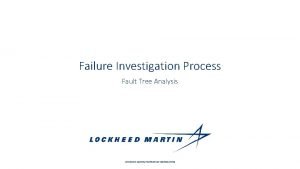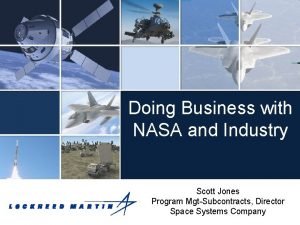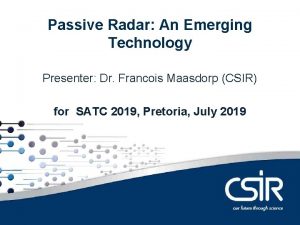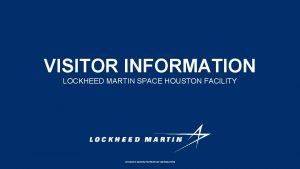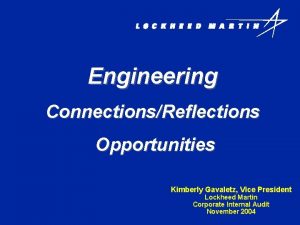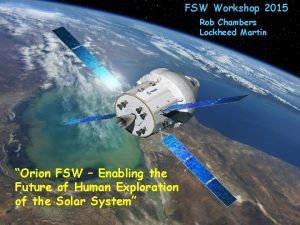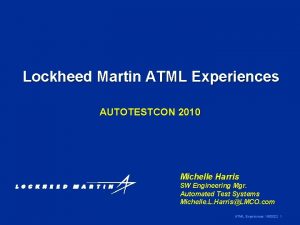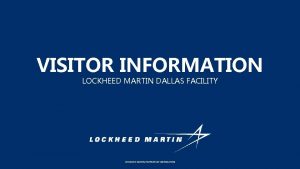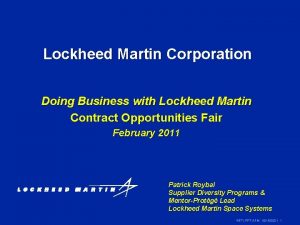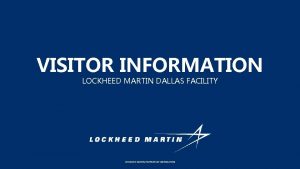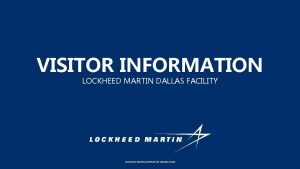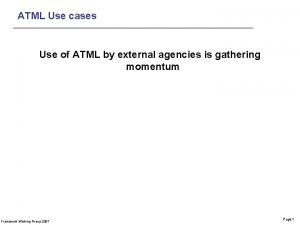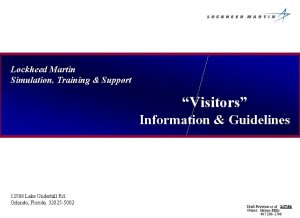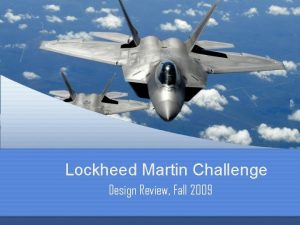Lockheed Martin Simulation Training Support ATML on Michelle














- Slides: 14

Lockheed Martin Simulation, Training & Support ATML on Michelle Harris ® LM-STAR Alicia Helton 407 -306 -1592 407 -306 -6693 Michelle. L. Harris@lmco. com Alicia. Helton@lmco. com Steven O’Donnell 407 -306 -4325 Steven. J. O’Donnell@lmco. com

Introduction Lockheed Martin Simulation, Training & Support Implemented a set of ATML schemas on LM-STAR® Schemas used – Test. Description ML (draft 5. 0) Test. Results ML (version 0. 15) Diagnostic ML Bayes Common Element Model (CEM) Dynamic Context Model (DCM – version 0. 07) 2

Lockheed Martin Simulation, Training & Support Task Definition Convert a legacy CASS ATLAS TPS into ATML Test. Description. Use Test. Description as input to the SELEX TPS Wizard™ and generate Test. Stand™ sequences. Execute the Test. Stand™ sequences on the LM-STAR®. Collect measured values using ATML Test. Results. Interface with diagnostic reasoner to isolate to the fault more quickly and more accurately. 3

Lockheed Martin Simulation, Training & Support Initial Approach Use an externally developed tool to convert ATLAS to Intermediate XML Use XML tools to transform the Intermediate XML to Test. Description will provide the “what” to do information for the TPS Use the TPS Wizard™ to generate Test. Stand™ sequence files capable of being run on LM-STAR®. ATLAS Intermediate XML ATML Test Description Test. Stand Sequence Files 4

Lockheed Martin Simulation, Training & Support Issues Legacy ATLAS TPS was not designed to maximize portability Intermediate XML generated from ATLAS was very flat Difficult to understand test flow and translate into Test. Description Legacy ATLAS TPS didn’t adhere to style guide which would have enforced specific design rules Multiple fault callout permutations based on data evaluations made without test numbers created problems in the diagnostic model development 5

Lockheed Martin Simulation, Training & Support Revised Approach Test 2000 Test Group 1 Next on Fail DIAGNOSTIC 1 Next on Pass 2010 Human intervention verified the information and added missing values. Callout on Fail A 4 High Limit 25 Low Limit NA An application was written to convert the spreadsheet to Test. Description. Comparison EQ Units Ohm Entry Point No An application was developed to extract the “what” to do information from the ATLAS and save it to a spreadsheet. 6

Lockheed Martin Simulation, Training & Support Test. Description Sample <Outcomes> <Outcome ID="0_1" value="Passed"/> <Outcome ID="0_2" value="Failed"/> <Outcome ID=" DIAGN 1" value="Failed"> <Replace. Components> <Replace. Component uut. Component. Id="UUT-0"/> </Replace. Components> </Outcome> <Outcome ID=" DIAGN 1" value="Failed"> <Replace. Components> <Replace. Component uut. Component. Id="UUT-1"/> </Replace. Components> </Outcome> ------snipped-----<Step xsi: type="Step_Test" ID="Step_2" test. Id="2000"> <Results> <Result xsi: type="Result_Test" test. Outcome. Id="2000 A"> <Next. Step step. Id="Step_3"/> <!-- 2020 --> </Result> Using the information from Test. Description, the Selex TPS Wizard™ builds the frame of the new TPS with initiated variables, test criteria, simulation mode, pre and post conditions, and calls to “how-to” sequences. 7

Lockheed Martin Simulation, Training & Support Test. Description to LM-STAR® Needed to create the “how-to” Test. Stand™ Sequences Highly intensive manual task Simplified through the use of Custom Steps Graphical interface to LM-STAR® system software 8

Lockheed Martin Simulation, Training & Support Diagnostic Model Description Model is based off the Bayesian and Common Element Models from the AI-ESTATE standard Stored in XML format derived from the AI-ESTATE models Development of Model Start with the fault tree of the TPS Use historical test results and maintenance data to add more intelligence to the Model Learning algorithms are used to continuously feed back newly discovered test results (in Test. Results ML format) and maintenance data 9

Lockheed Martin Simulation, Training & Support Diagnostic Reasoner Provides run-time environment for using the diagnostic models Implements the AI-ESTATE interface to the diagnostic models Uses the Dynamic Context Model to track session information Allows for back-tracking through session Allows restart of Session from previous stopping point Provides a set of “higher-order” interface functions to minimize required calls for accessing model/reasoner data Web-service based interface (using WSDL) Utilizes a Bayesian Network Analyzer called SMILE By Decisions System Laboratory – Univ. of Pittsburgh 10

Lessons Learned Lockheed Martin Simulation, Training & Support Our current process is still heavily dependent on manual intervention. Very time-consuming Current legacy TPSs are implemented with tight coupling making it difficult to separate the “what” and “how” information Other ATML schemas such as UUT Description and Test. Adapter could aid in the porting process They were not mature enough at the time the task started Would be more cost effective to implement UUT test requirements on new systems as opposed to re-hosting the application Not always a one-to-one test mapping from TPS to Diagnostic Model 11

Conclusion Lockheed Martin Simulation, Training & Support Industry needs tools that can generate and consume ATML that could be exported to C, ATLAS etc Using IEEE-1641 for Signal and Test Definition appears promising and further study by Lockheed Martin is planned Lockheed Martin is embracing ATML Test. Results ML is deployed on LM-STAR® systems supporting the JSF program As ATML matures, Lockheed Martin is prepared to implement this technology into our legacy and future programs 12

Lockheed Martin Simulation, Training & Support DEMONTSTRATION 13

Lockheed Martin Simulation, Training & Support Questions Michelle Harris 407 -306 -6693 Alicia Helton 407 -306 -1592 Michelle. L. Harris@lmco. com Alicia. Helton@lmco. com Steven O’Donnell 407 -306 -4325 Steven. J. O’Donnell@lmco. com 14
 Lockheed martin cyberquest
Lockheed martin cyberquest Lockheed martin lake underhill
Lockheed martin lake underhill Lockheed martin factory
Lockheed martin factory 230 mall boulevard king of prussia
230 mall boulevard king of prussia Lockheed martin georgia
Lockheed martin georgia Lockheed martin greenville sc address
Lockheed martin greenville sc address Lockheed martin mbse
Lockheed martin mbse Lockheed martin information systems & global solutions
Lockheed martin information systems & global solutions Lockheed martin investigation
Lockheed martin investigation Scott jacobsen lockheed martin
Scott jacobsen lockheed martin Slg4 aircraft
Slg4 aircraft Lockheed martin houston tx
Lockheed martin houston tx Błażej kantak
Błażej kantak Lockheed martin organizational chart
Lockheed martin organizational chart Rob chambers lockheed martin
Rob chambers lockheed martin

